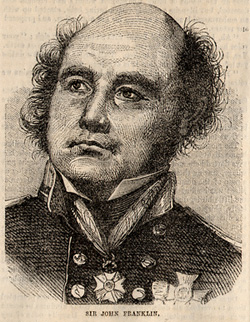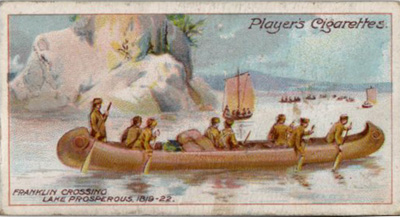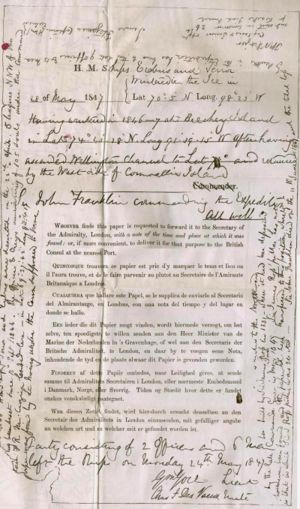John Franklin: Difference between revisions
imported>Russell Potter (add see also) |
imported>Russell Potter m (→See also) |
||
| Line 89: | Line 89: | ||
==See also== | ==See also== | ||
*[[Northwest | *[[Northwest Passage]] | ||
==References== | ==References== | ||
Revision as of 14:13, 11 June 2007
Rear Admiral Sir John Franklin FRGS (April 15, 1786 - June 11, 1847) was a British sea captain and Arctic explorer whose final expedition disappeared while attempting to chart and navigate the Northwest Passage in the Canadian Arctic. The entire crew was lost and its fate remained a mystery for 14 years; even today his ships have never been found, and the ultimate fate of the last survivors is largely unknown.
Early Career
Franklin was born in Spilsby, Lincolnshire in 1786 and educated at King Edward VI Grammar School, Louth. He was the ninth of 12 children of a family which had prospered in trade. One of his sisters became the mother of Emily Tennyson (wife of the poet).
Although his father initially opposed him, Franklin was determined to have a career at sea. Reluctantly, his father allowed him to go on a trial voyage with a merchant ship. This hardened young Franklin's resolve, so at the age of 14, his father secured a Royal Navy appointment on HMS Polyphemus. Franklin was later present at the Battle of Copenhagen in 1801. Following this he went on an expedition to explore the coast of Australia on the HMS Investigator with his uncle, Captain Matthew Flinders. Following that expedition, he returned to the Napoleonic Wars, serving aboard HMS Bellerophon at the Battle of Trafalgar in 1805. In 1815, he was at the Battle of New Orleans.
First Expedition
Franklin first travelled to the Arctic in 1818, as a lieutenant under the command of David Buchan, aboard the ships Dorothea and Trent. Their mission was to forge a direct way north beyond Henry Hudson's old record of 80 degrees of latitude. The most optimistic of those who saw them off was Second Secretary of the Admirality Sir John Barrow who, influenced in part by whaler William Scoreseby's reports of unusually large areas of open water and melting ice the year before, believed that this was an ideal time to search for the long-sought (but ultimately chimerical) Open Polar Sea. Buchan and Franklin's ships, unfortunately, met with heavy, gale-driven sea ice just north of the Spitzbergen Islands, and after making emergency repairs were forced to head home. For Franklin, it was his first taste of Arctic adventure, and the fascination was to prove a life-long one. Despite its limited success, the expedition was celebrated in the press, and depicted in an enormous Panoramic painting by Henry Aston Barker at his establishment in Leicester Square in London.
Second Expedition
Franklin's second expedition, and the first under his direct command, was sent overland via the Great Slave Lake and the Coppermine River in 1819-1822 to explore the shores of the "Polar Sea." Disputes with the Hudson's Bay Company and the North-West Company over supplies led to delays, and several of the men under Franklin's command quit before the final departure. In the end, only Franklin and three other officers (suregeon-naturalist John Richardson and midshipmen George Back and Robert Hood), and one lone sailor, John Hepburn set off with a company of hired voyageurs and a party of guides from the Dene tribe.
The expedition proved to be a disaster. While he did reach the northern coast and explored a small part of it, the expedition's canoes were damaged beyond repair; on the return journey on foot Franklin lost 11 of the 20 men in his party. Most died of starvation, but there was also at least one murder and suggestions of cannibalism. The survivors were forced to eat lichen, old deerskins, and even their own leather boots. This gained Franklin the nickname of "the man who ate his boots".
Third Expedition
In 1823, after returning to England, Franklin married the poet Eleanor Porden. She died of tuberculosis in 1825, shortly after persuading her husband not to let her ill-health prevent him from setting off on another expedition to the Arctic. This expedition, a voyage down the Mackenzie River to further explore the shores of the "Polar Sea", was better supplied and more successful than his last. Specially-built boats with stronger hulls performed much better than the voyageurs' canoes, and with them Franklin and Dr. Richardson, who led two separate parties from the mouth of the Mackenzie, explored hundreds of miles of previously uncharted coastline.
Governor of Tasmania
In 1828, Franklin was knighted by George IV and in the same year married Jane Griffin, a seasoned traveller who proved indomitable in the course of their life together. He was appointed Governor of Tasmania in 1836, but was recalled from office in 1843, after his Colonial Secretary George Arthur undermined his authority. Arthur and his supporters resented Franklin's attempts to reform the penal colony, and especially took umbrage at what they saw as too large a role in public affairs taken by Lady Jane Franklin. Nevertheless, he was popular among many of the people of Tasmania, who, upon his death, erected a statue of him in Franklin Square, in Hobart.
Final expedition
Exploration of the Arctic coastal mainland since Franklin's last Arctic expedition had left less than 500 km of unexplored Arctic coastline. It was decided that a well-equipped Arctic expedition would be sent to finally chart the Northwest Passage. Franklin was eager to lead the expedition, and was given command on February 7, 1845. As second-in-command, the Admiralty selected Francis Rawdon Moira Crozier, a veteran of numerous Arctic expeditions. The expedition, with a final complement of 128 men, set sail from Greenhithe on the Thames on May 19, 1845, in two ships, HMS Erebus and HMS Terror.
The ships were sturdily built, and had been outfitted with steam heating for the comfort of the crew, large amounts of reading and educational material, and three years' worth of preserved food supplies. Converted railway engines served to turn two screw propellors, though these were only expected to be used occasionally. They were last seen by whalers at Baffin Bay on July 26. The remainder of their route can be reconstructed from the evidence found years later; after entering Lancaster Sound, they proceeded through Barrow Strait, and managed to circumnavigate Cornwallis Island. Fresh from this achievement, they wintered in a protected cove at Beechey Island, where they left signs that an observatory, a forge, and even a garden, had been established on the shore.
The Franklin Search
After two years and no word from the expedition, Lady Jane Franklin, his wife, urged the Admiralty to send a search party. The alarm was slow to grow, however; since the crew carried supplies for three years, the Admiralty waited another year before launching the search and offering a £20,000 reward for success. Not only was this a huge sum for the time, but Franklin's disappearance had captured the popular imagination. At one point, there were 10 British and two American ships headed for the Arctic. (More ships and men were lost looking for Franklin than in the expedition). Ballads telling of Franklin and his fate became popular. The ballad Lady Franklin's Lament commemorated Lady Franklin's search for her lost husband.
In the summer of 1850, several of the ships converged on Beechey Island, in Wellington Channel, where the first relics of the Franklin expedition were found: a winter encampment with the remains of an observatory, a smithy, an attempt at a garden, and -- most ominously -- the graves of three of Franklin's sailors who had died from natural causes in the winter of 1845-46. Despite extensive searching, no messages were found to have been left there by the Franklin party to provide any indication of his progress or intentions. The bodies of the sailors had been preserved in the frozen ground, and autopsies conducted when the bodies were exhumed in the mid-1980's found that tuberculosis was the most immediate cause of death, though there was also toxicological evidence of lead poisoning.
In 1854, explorer John Rae discovered further evidence of the Franklin party's fate. Rae was not searching for Franklin at all, but rather exploring the Boothia Peninsula on behalf of the Hudson's Bay Company. On this journey, Rae met an Inuk who told him of a party of 35 to 40 white men who had died of starvation near the mouth of the Back River. The Inuit also showed him many objects that were identifiable as having belonged to Franklin and his men.
Lady Franklin commissioned one more expedition under Francis Leopold McClintock to investigate Rae's report. In the summer of 1859, the McClintock party found a document in a cairn on King William Island left by Franklin's second-in-command, giving the date of Franklin's death. The message, dated April 25, 1848, also reported that the ships had been trapped in the ice, that many others had died, and that the survivors had abandoned the ships and headed south towards the Back River. McClintock also found several bodies and an astonishing amount of abandoned equipment, and heard more details from the Inuit about the expedition's disastrous end.
There are several things that contributed to the loss of the Franklin expedition. Like most men of his generation and training, Franklin was culturally conservative, observing wasteful rituals in inappropriate locales; for example, he and his men carried silver plate, crystal decanters, and many extraneous personal effects with them. They attempted to haul much of this heavy gear along with them even after abandoning the ships. They were unwilling or unable to learn survival techniques from the Inuit. Moreover, their expedition was a naval one, not equipped for hiking over land, so none of the sailors had thick boots or jackets. Their ships were locked in the ice for two winters running as a result of a colder period that did not allow the icebound passages to melt in the summer of 1846. The party's morale and cohesion was damaged by psychological effects of lead poisoning from the solder that sealed their tinned food supply. This has been confirmed by lead found in both skeletal and soft tissue remains of expedition sailors conducted by Dr Owen Beattie of the University of Alberta. They also were weakened by internal bleeding from scurvy after the first two years when the preventive lemon juice they carried lost its potency. The Inuit witnesses had reported that crew members exhibited the blackened mouth and bruised skin typical of that disease.
Skeletal remains examined by Dr. Anne Keenleyside showed evidence of cut marks found on bones from some of the crew, which strongly suggests conditions were so dire that some resorted to cannibalism. In the end, it was likely a combination of poor planning, bad weather, poisoned food, and ultimately starvation that killed them.
For years to come, however, the Victorian media chose to portray Franklin as a hero, leading his men in the quest for the Northwest Passage. At the constant pressure of Lady Franklin, stories about the expedition's disappointing demise were suppressed, and her husband was elevated to a hero. A statue of Franklin in his home town bears the inscription 'Sir John Franklin - Discoverer of the North West Passage'. Statues of Franklin outside the Athenaeum in London, and in Tasmania, bear similar inscriptions.
An alternative view is that Franklin was portrayed as a hero because of his many achievements, and the fact that he died in a gallant attempt to complete his discovery of the Northwest Passage did not diminish his standing in the eyes of the public. The expedition's fate, including the possibility of cannibalism, was not suppressed but in fact widely reported and debated in the newspapers of the day. The mystery still surrounding Franklin's last expedition was the subject of a 2006 episode of the NOVA TV series, Arctic Passage.
Literary works inspired by Franklin
From the moment of his disappearance on his final expedition, the mystery and tragedy surrounding Franklin's voyage stirred poets, balladeers, and novelists to their own expressions of loss and elegy.
The mid 1850's saw three book-length works in verse, Abrahall, Chandos Hoskyns Abrahall's Arctic enterprise A poem (1856), James Parsons' Reflections on the mysterious fate of Sir John Franklin (1857), and Joseph Addison Turner's The Discovery of Sir John Franklin, and other poems (1858). In 1860, with the discovery of the final note at Victory Point, several instututions, among them Oxford University, held contests for the best poetic elegy. The Oxford contest was won by a Canadian undergraduate, Owen Alexander Vidal, for his 'A Poem upon the life and character of Sir John Franklin.' which is almost unreadably wretched; far better was a poem which did not win, Charles Algernon Swinburne's The Death of Sir John Franklin. Franklin then faded as a subject of poetry for a century, re-emerging in 1960 in Canadian poet Gwendolyn MacEwen's Erebus and Terror, originally written for CBC radio. The most notable recent poetic treatment of Franklin has been David Solway's Franklin's Passage (2003), which was awarded the 36th annual Grand Prix du Livre by the City of Montréal, a first for an Anglophone writer.
Charles Dickens was greatly enamored of Franklin's achievements, and it was at his suggestion and with his support that Wilkie Collins undertook a play, The Frozen Deep, which appeared in 1857 to tremendous acclaim. Originally staged in Dickens's home, it later received a command performance before Queen Victoria, as well as a series of performances in Manchester. Dickens also wrote a long prose essay, "The Lost Arctic Voyagers," which commemorated Franklin's achievement and defended him against his detractors. Henry David Thoreau, though he dismissed Franklin's achievements and urged his readers to seek their own internal "higher latitudes", followed the Franklin story closely, and Joseph Conrad, in his essay "Geography and Some Explorers," credited Franklin's story with inspiring both his career as a seaman and as a novelist.
Franklin did not emerge info fiction until later in the twentieth century, but since 1965 there have been no fewer than a dozen novels based on his expedition. Beginning with Australian novelist Nancy Catto's North-West by South, we then have Caroline Tapley's John come down the backstay (1974), Sten Nadolny's The Discovery of Slowness (Die Entdeckung der Langsamkeit) (1983), Martyn Godfrey's Mystery in the frozen lands (1988), Mordecai Richler's Solomon Gursky Was Here (1990), William T. Vollmann's The Rifles (1994), Rudy Wiebe's A DIscovery of Strangers (1994), Robert Edric's The Broken Lands (2002), John Wilson's Across Frozen Seas (1997) and North With Franklin: The Journals of James Fitzjames (1999), Elizabeth McGregor's The Ice Child (2001), and Dan Simmons' Terror (2007).
Franklin in popular culture
- The 1981 song Northwest Passage by Stan Rogers makes reference to John Franklin.
- The ballad Lady Franklin's Lament, aka Lord Franklin, has been recorded by numerous artists, including Martin Carthy, Pentangle, Sinéad O'Connor, and the Pearlfishers. The melody was also used for Bob Dylan's song Bob Dylan's Dream, as well as David Wilcox's Jamie's Secret, the latter a song about a young woman who is lost in the frozen foothills of the North Cascades mountains.
- The song I'm Already There on the Fairport Convention album Over the Next Hill is sung from the point of view of a member of one of Franklin's Expeditions.
- The song "900," the B-side to the Breeders' 1993 Cannonball single, has lyrics based on the Franklin expedition, particularly referencing the unnecessary luggage they carried south.
List of Franklin search expeditions
- 1848–1849, James Clark Ross in Investigator and Enterprise
- 1848–1851, John Richardson and John Rae overland expedition
- 1848–1851, Plover and Herald via Bering Strait
- 1849 William Penney (Captain) John Anstruther Goodsir (naturalist) in whaling vessel Advice
- 1850–1854, Robert McClure in Investigator via Bering Strait
- 1850–1855, Richard Collinson in Enterprise via Bering Strait
- 1850–1851, William Penny in Lady Franklin and Sophia
- 1850–1851, Horatio T. Austin in four-ship Royal Navy expedition
- 1850–1851, Sir John Ross in private expedition
- 1850, Charles Codrington Forsyth in Prince Albert, financed by Lady Franklin
- 1850–1851, Edwin J. De Haven in first Grinnell expedition
- 1851–1852, William Kennedy and Joseph René Bellot in Prince Albert, financed by Lady Franklin
- 1852–1854, Sir Edward Belcher in a five-ship Royal Navy expedition
- 1852, Edward Augustus Inglefield in Isabel, financed by Lady Franklin
- 1853–1855, Elisha Kent Kane in second Grinnell expedition
- 1853–1854, John Rae on behalf of the Hudson Bay Company
- 1857–1859, Francis Leopold McClintock in Fox, financed by Lady Franklin
- 1864–1869, Charles Francis Hall
- 1875, Allen Young in Pandora, in a private expedition
- 1876, Allen Young in Pandora, in a second private expedition which also took despatches to the expedition of Sir George Nares for the Admiralty
- 1878–1880, Frederick Schwatka, sponsored by the American Geographical Society
See also
References
- NOVA - Arctic Passage Part 1 - Prisoners Of The Ice (TV documentary)
- Frozen In Time: The Fate of the Franklin Expedition, Owen Beattie and John Geiger
- The Arctic Grail, Pierre Berton
- Deadly Winter, Martyn Beardsley
- The Royal Navy in Polar Exploration, Frobisher to Ross, E C Coleman 2006 ISBN 0-7524-3660-0
- The Royal Navy in Polar Exploration, Franklin to Scott, E C Coleman 2006
- British polar exploration and research : a historical and medallic record with biographies, 1818-1999 , Neville W. Poulsom & J. A. L. Myres (London: Savannah 2000)
- Franklin Saga Deaths: A Mystery Solved? National Geographic Magazine, Vol 178, No 3, Sep 1990
- The Artic Fox - Francis Leopold McClintock, Discoverer of the fate of Franklin, David Murray, 2004. Cork: The Collins Press, ISBN 1-55002-523-6




